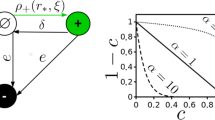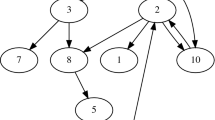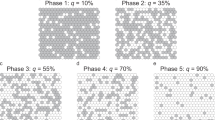Abstract
Assessing the fate of species endangered by habitat fragmentation1,2,3 using spatially explicit and individual-based models4,5,6,7 can be cumbersome and requires detailed ecological information that is often unavailable. Conversely, Levins-like8 macroscale models9,10 neglect data on the distribution of local numbers, which are frequently collected by field ecologists11,12,13. Here we present an alternative, mesoscale approach for metapopulations that are subject to demographic stochasticity, environmental catastrophes and habitat loss. Starting from a model that accounts for discrete individuals in each patch and assumes a birth–death stochastic process with global dispersal14,15, we use a negative-binomial approximation16 to derive equations for the probability of patch occupancy and the mean and variance of abundance in each occupied patch17. A simple bifurcation analysis18 can be run to assess extinction risk. Comparison with both the original model and a spatially explicit model with local dispersal proves that our approximation is very satisfactory. We determine the sensitivity of metapopulation persistence to patch size, catastrophe frequency and habitat loss, and show that good dispersers are affected more by habitat destruction than by environmental disasters.
This is a preview of subscription content, access via your institution
Access options
Subscribe to this journal
Receive 51 print issues and online access
$199.00 per year
only $3.90 per issue
Buy this article
- Purchase on Springer Link
- Instant access to full article PDF
Prices may be subject to local taxes which are calculated during checkout



Similar content being viewed by others
References
Bascompte, J. & Solé, R. V. Habitat fragmentation and extinction thresholds in spatially explicit models. J. Anim. Ecol. 65, 465–473 (1996).
Hanski, I., Gilpin, M. (eds) Metapopulation Biology: Ecology, Genetics, and Evolution (Academic, San Diego, California, (1997).
Hanski, I. Metapopulation dynamics. Nature 396, 41–50 (1998).
Tilman, D. & Kareiva, P. Spatial Ecology (Princeton Univ. Press, New Jersey, (1997).
Bascompte, J. & Solé, R. V. Modeling Spatiotemporal Dynamics in Ecology (Springer, Berlin, (1998).
De Angelis, D. L. & Gross, L. J. (eds) Individual-Based Models and Approaches in Ecology (Chapman & Hall, New York, (1992).
Nowak, M. A. & May, R. M. Evolutionary games and spatial chaos. Nature 359, 826–829 (1992).
Levins, R. Some demographic and genetic consequences of environmental heterogeneity for biological control. Bull. Entomol. Soc. Am. 15, 237–240 (1969).
Gotelli, N. J. Metapopulation models: The rescue effect, the propagule rain, and the core-satellite hypothesis. Am. Nat. 138, 768–776 (1991).
Day, J. R. & Possingham, H. P. Astochastic metapopulation model with variability in patch size and position. Theor. Popul. Biol. 48, 333–360 (1995).
den Boer, P. J. Density limits and survival of local populations in 64 carabid species with different power of dispersal. J. Evol. Biol. 3, 19–48 (1990).
Whitlock, M. C. Nonequilibrium population structure in forked fungus beetles: extinction, colonization and the genetic variance among populations. Am. Nat. 139, 952–970 (1992).
Crawley, M. J. & Brown, S. L. Seed limitation and the dynamics of feral oilseed rape on the M25 motorway. Proc. R. Soc. Lond. B 259, 49–54 (1995).
Chesson, P. L. Models for spatially distributed populations: The effect of within-patch variability. Theor. Popul. Biol. 19, 288–325 (1981).
Drechsler, M. & Wissel, C. Separability of local and regional dynamics in metapopulations. Theor. Popul. Biol. 51, 9–21 (1997).
Anderson, R. M. & May, R. M. Regulation and stability of host–parasite population interactions—I. Regulatory processes. J. Anim. Ecol. 47, 219–247 (1978).
Bolker, B. M. & Pacala, S. W. Using moment equations to understand stochastically driven spatial pattern formation in ecological systems. Theor. Popul. Biol. 52, 179–197 (1997).
Kuznetsov, Y. A. Elements of Applied Bifurcation Theory (Springer, New York, (1995).
Kareiva, P. & Wennergren, V. Connecting landscape patterns to ecosystem and population process. Nature 373, 299–302 (1995).
Olivieri, I., Michalakis, Y. & Gouyon, P. H. Metapopulation genetics and the evolution of dispersal. Am. Nat. 146, 202–228 (1995).
Chesson, P. L. Persistence of a Markovian population in a patchy environment. Z. Wahrscheinlichkeitstheorie 66, 97–107 (1984).
Lande, R. Risks of population extinction from demographic and environmental stochasticity and random catastrophes. Am. Nat. 142, 911–927 (1993).
Chesson, P. L. in Modeling Spatiotemporal Dynamics in Ecology (eds Bascompte, J. & Solé, R. V.) (Springer, Berlin, (1998).
Wolfram, S. Cellular Automata and Complexity: Collected Papers (Addison-Wesley, Reading, Massachusetts, (1994).
Durrett, R. & Levin, S. The importance of being discrete (and spatial). Theor. Popul. Biol. 46, 363–364 (1994).
Tucker, G. M. & Heath, M. F. Birds in Europe. Their Conservation Status (Birdlife International, Cambridge, (1994).
Pugliese, A., Rosà, R. & Damaggio, M. L. Analysis of a model for macroparasitic infection with variable aggregation and clumped infections. J. Math. Biol. 36, 419–447 (1998).
Kendall, M. & Stuart, A. The Advanced Theory of Statistics (Griffin, London, (1977).
Acknowledgements
We thank G. De Leo, C. Dimou and I. Hanski for suggestions. We thank Politecnico di Milano for support.
Author information
Authors and Affiliations
Corresponding author
Rights and permissions
About this article
Cite this article
Casagrandi, R., Gatto, M. A mesoscale approach to extinction risk in fragmented habitats. Nature 400, 560–562 (1999). https://doi.org/10.1038/23020
Received:
Accepted:
Issue Date:
DOI: https://doi.org/10.1038/23020
This article is cited by
-
Persistence of amphibian metapopulation occupancy in dynamic wetlandscapes
Landscape Ecology (2022)
-
How Levins’ dynamics emerges from a Ricker metapopulation model
Theoretical Ecology (2016)
-
Spatio-temporal impacts of roads on the persistence of populations: analytic and numerical approaches
Landscape Ecology (2011)
-
Floristic and structural changes related to opportunistic soil tilling and pasture planting in grassland communities of the Flooding Pampa
Biodiversity and Conservation (2007)
-
Convergence of a structured metapopulation model to Levins?s model
Journal of Mathematical Biology (2004)
Comments
By submitting a comment you agree to abide by our Terms and Community Guidelines. If you find something abusive or that does not comply with our terms or guidelines please flag it as inappropriate.



